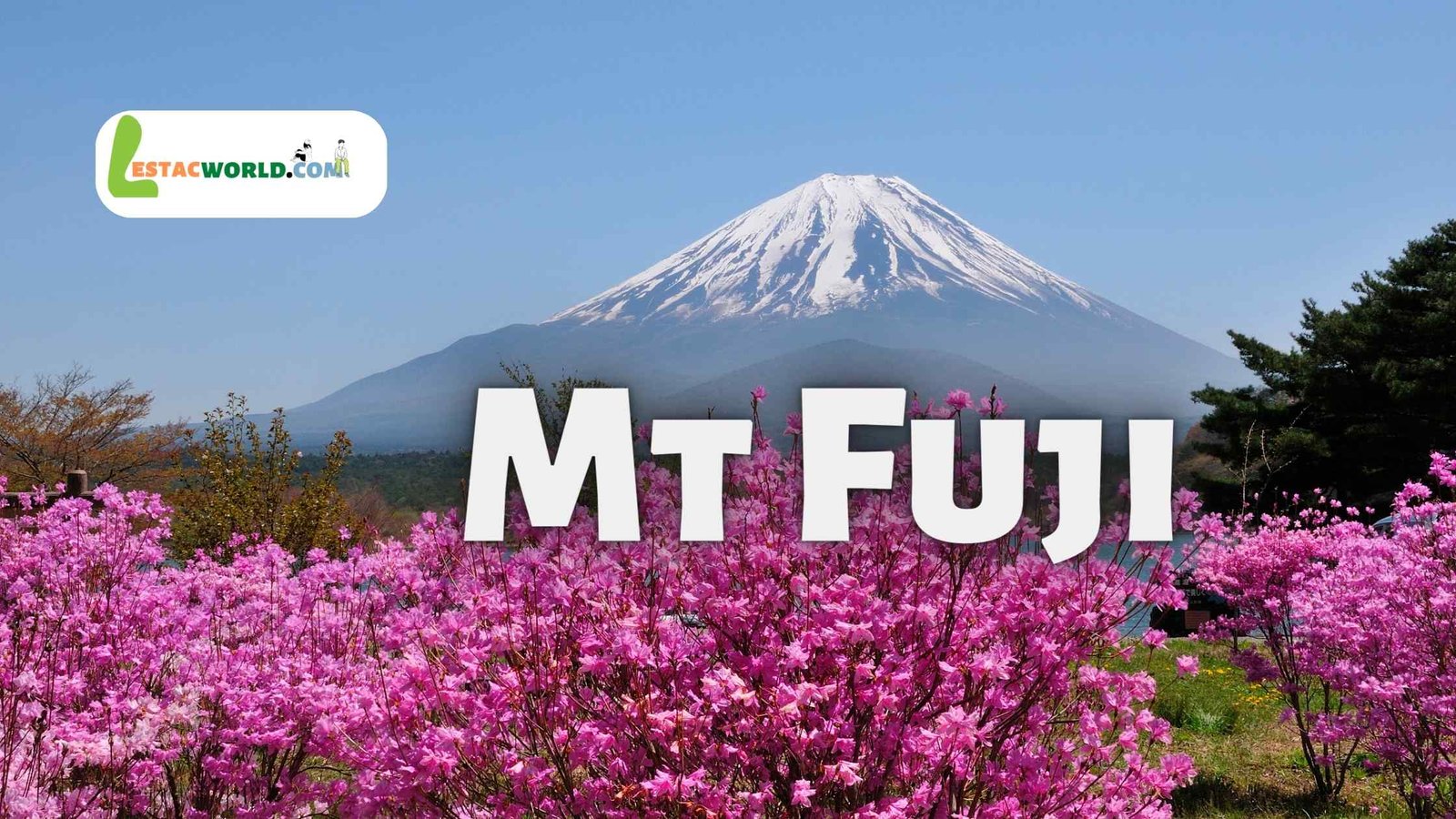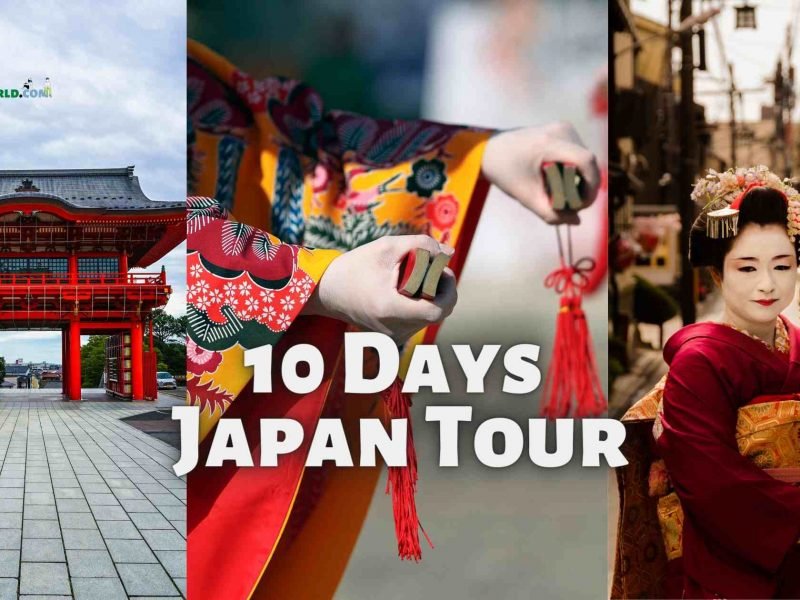About Mt Fuji
About Mt Fuji- Mount Fuji is an active volcano that stands at 3,776 meters (12,389 ft) tall and is also known by its Japanese name, Fujisan. On the island of Honshu, roughly 100 kilometers (60 miles) to the southwest of Tokyo is where you’ll find it. Mount Fuji, which is located in Japan, is a UNESCO World Heritage site and is widely regarded as the nation’s most recognizable symbol.
The beginning of July to the middle of September is considered to be the climbing season for Mount Fuji. This is the time of year when a large number of tourists and climbers visit the mountain to attempt to reach the peak. The mountain features a number of different hiking trails that are interspersed with mountain cottages that can be used for lodging and resting along the journey.
Shinto, the traditional religion of Japan, is closely tied with the mountain because of its cultural and religious significance. The mountain’s natural splendor has been the source of creativity for a great number of poets and painters, and it is particularly famous for the breathtaking vistas it affords during the cherry blossom season in the spring and the autumn leaves season in the fall.
The surrounding area of Mount Fuji is a part of the Fuji-Hakone-Izu National Park, so visitors can enjoy a wide variety of activities there, including climbing, hiking, skiing, and soaking in hot springs. In addition, there is ecological diversity on the mountain, and it is home to a wide variety of plant and animal species.
History time line of Mt Fuji
Here is a brief history timeline of Mount Fuji:
- Around 100,000 years ago: The formation of Mount Fuji begins with repeated eruptions of lava and ash.
- 8th century: The mountain is named “Fuji” after the Buddhist fire goddess Fuchi.
- 16th century: Mount Fuji becomes a popular pilgrimage destination for followers of the Shinto religion.
- 1707-1708: The last eruption of Mount Fuji occurs, which forms a new peak called Hoeizan.
- 1868: The Meiji government officially recognizes Mount Fuji as a national symbol of Japan.
- 1886: The first recorded successful ascent to the summit of Mount Fuji is made by Englishman William Gowland.
- 1951: Mount Fuji is designated as a special place of scenic beauty and a national park.
- 2013: Mount Fuji is added to the UNESCO World Heritage list as a cultural site, recognized for its role as a source of artistic inspiration and its importance in Japan’s cultural heritage.
Throughout its history, Mount Fuji has been a prominent figure in Japanese art, literature, and religion. It has also been the subject of scientific study and conservation efforts due to its ecological importance and status as an active volcano.
How to reach Mt Fuji from Tokyo?
There are several ways to reach Mount Fuji from Tokyo, depending on your preference and budget. Here are some common options:
- Mt Fuji by train: Take the JR Chuo Line from Tokyo Station to Otsuki Station, and then transfer to the Fujikyu Railway to Kawaguchiko Station. The entire journey takes about 2-3 hours, and you can enjoy scenic views of the countryside and Mount Fuji along the way. From Kawaguchiko Station, you can take a bus or taxi to various sights around Mount Fuji.
- Mt Fuji by bus: Many bus companies offer direct services from Tokyo to Mount Fuji or nearby stations such as Kawaguchiko, Fuji-Q Highland, or the Fifth Station, which is the starting point for most climbers. The journey takes around 2-3 hours depending on traffic and the destination.
- Mt Fuji by car: Renting a car or taking a taxi is another option, especially if you prefer a more flexible and private mode of transportation. The journey takes around 2-3 hours depending on traffic and the destination, and you can stop at various scenic spots along the way.
- Mt Fuji by tour agencies: Joining a guided tour is a convenient and hassle-free way to visit Mount Fuji from Tokyo. Many tours include transportation, admission fees, and a knowledgeable guide who can provide insights into the mountain’s history and culture. Tours are available in different languages and themes, such as hiking, sightseeing, or photography.
It’s important to note that Mount Fuji is only open to climbers during the official climbing season from early July to mid-September, and outside of this period, some hiking trails or facilities may be closed or limited.
Do's and Dont's at Mt Fuji ?
Here are some do’s and don’ts to keep in mind when visiting or climbing Mount Fuji:
Do’s:
- Do check the weather forecast and volcanic activity before going, as Mount Fuji’s weather can change rapidly and eruptions can occur.
- Do dress appropriately for the mountain’s climate and elevation, and bring warm clothing, rain gear, sunscreen, and sturdy hiking boots.
- Do bring enough food and water, as there are limited facilities along the hiking trails and at the summit.
- Do respect the mountain’s natural environment and cultural significance, and follow the Leave No Trace principles to minimize your impact on the mountain.
- Do obey the rules and guidelines set by the park authorities, such as no smoking, no littering, no loud noise, and no off-trail hiking.
- Do practice safety precautions such as hiking in groups, staying on designated trails, and carrying a map, compass, and flashlight.
- Do enjoy the scenic views and cultural experiences that Mount Fuji offers, such as cherry blossoms, hot springs, or visiting a Shinto shrine.
Don’ts:
- Don’t climb Mount Fuji outside of the official climbing season, as it can be dangerous and the facilities may be closed.
- Don’t underestimate the difficulty and altitude of climbing Mount Fuji, and don’t attempt to climb to the summit if you are not physically fit or have health issues.
- Don’t ignore signs of altitude sickness or other health problems, and seek medical help if needed.
- Don’t litter, damage, or remove any natural or cultural resources on the mountain.
- Don’t disturb the wildlife or plant species on the mountain.
- Don’t disregard safety precautions, such as crossing safety lines, leaving the trail, or ignoring warning signs.
- Don’t disrespect the local customs and culture, and follow the etiquette when visiting a shrine or other cultural sites.
Attractions at Mt Fuji ?
There are several attractions and activities to enjoy at Mount Fuji, ranging from scenic spots to cultural experiences. Here are some of the most popular ones:
- Climbing and hiking: Mount Fuji is Japan’s highest mountain and a popular hiking destination, with several trails leading to the summit. The official climbing season is from early July to mid-September, and climbers need to obtain a climbing permit and prepare for the challenging terrain and altitude.
- Scenic spots: Mount Fuji offers breathtaking views of the surrounding landscape, such as the Five Lakes area, which offers various hiking trails, hot springs, and panoramic views of the mountain. Other popular viewpoints include the Chureito Pagoda, Lake Yamanaka, and the Mount Fuji Fifth Station.
- Cultural experiences: Mount Fuji is an important part of Japan’s cultural heritage and offers various cultural experiences, such as visiting a Shinto shrine or Buddhist temple, participating in a tea ceremony, or trying traditional Japanese cuisine. The Fujisan World Heritage Center and the Fuji-Q Highland amusement park also offer educational and entertainment activities.
- Hot springs: Mount Fuji is known for its natural hot springs or onsen, which offer relaxation and therapeutic benefits. The hot springs in the Five Lakes area, such as Yurari or Kirari Fujigoko, offer panoramic views of the mountain and the lake.
- Cherry blossoms: In spring, Mount Fuji’s slopes are covered with cherry blossoms, creating a stunning pink and white landscape. Popular cherry blossom spots include the Arakurayama Sengen Park, the Kawaguchiko Music Forest, and the Fuji Motosuko Resort.
- Winter sports: In winter, Mount Fuji offers various winter sports activities, such as skiing, snowboarding, and snowshoeing. The Mount Fuji Ski Resort, the Snowtown Yeti, and the Fujiten Snow Resort are popular destinations for winter sports enthusiasts.
- Cultural festivals: Mount Fuji hosts various cultural festivals throughout the year, such as the Fuji Shibazakura Festival, which features a carpet of pink moss phlox flowers, or the Fujiyoshida Fire Festival, which celebrates the mountain’s spiritual significance.
Highlights of Mt Fuji ?
Here are some of the highlights of Mount Fuji:
- Majestic peak: Mount Fuji is Japan’s highest mountain and a symbol of natural beauty and spiritual significance. The mountain’s distinctive conical shape and snow-capped peak have inspired artists, writers, and pilgrims for centuries.
- UNESCO World Heritage site: In 2013, Mount Fuji was designated as a UNESCO World Heritage site for its cultural and natural significance. The mountain is revered in Japanese culture and has been the subject of many artistic and literary works.
- Climbing and hiking: Climbing Mount Fuji is a popular activity, especially during the official climbing season from early July to mid-September. Hiking trails lead to the summit, offering stunning views of the surrounding landscape and a sense of accomplishment for those who reach the top.
- Scenic spots: Mount Fuji offers many scenic spots, such as the Five Lakes area, which provides panoramic views of the mountain, hot springs, and hiking trails. Other popular viewpoints include the Chureito Pagoda, Lake Yamanaka, and the Mount Fuji Fifth Station.
- Cultural experiences: Mount Fuji is an important part of Japan’s cultural heritage, and there are several cultural experiences to enjoy, such as visiting a Shinto shrine or Buddhist temple, participating in a tea ceremony, or trying traditional Japanese cuisine.
- Cherry blossoms: In spring, Mount Fuji’s slopes are covered with cherry blossoms, creating a stunning pink and white landscape. Popular cherry blossom spots include the Arakurayama Sengen Park, the Kawaguchiko Music Forest, and the Fuji Motosuko Resort.
- Hot springs: Mount Fuji is known for its natural hot springs or onsen, which offer relaxation and therapeutic benefits. The hot springs in the Five Lakes area, such as Yurari or Kirari Fujigoko, offer panoramic views of the mountain and the lake.
- Winter sports: In winter, Mount Fuji offers various winter sports activities, such as skiing, snowboarding, and snowshoeing. The Mount Fuji Ski Resort, the Snowtown Yeti, and the Fujiten Snow Resort are popular destinations for winter sports enthusiasts.
- Cultural festivals: Mount Fuji hosts various cultural festivals throughout the year, such as the Fuji Shibazakura Festival, which features a carpet of pink moss phlox flowers, or the Fujiyoshida Fire Festival, which celebrates the mountain’s spiritual significance.
Mt Fuji View Points
There are several view points from which you can see Mount Fuji. Here are some of the most popular ones:
- Chureito Pagoda: Located in the town of Fujiyoshida, the Chureito Pagoda is a five-story pagoda that offers a stunning view of Mount Fuji in the background. The pagoda is especially popular during cherry blossom season when the trees surrounding it are in bloom.
- Lake Kawaguchiko: The largest of the Five Lakes at the northern base of Mount Fuji, Lake Kawaguchiko offers beautiful views of the mountain, especially during the autumn foliage season when the leaves turn red and yellow.
- Arakurayama Sengen Park: Located in the town of Fujiyoshida, this park features a five-story pagoda and a winding staircase that offers a beautiful view of Mount Fuji and the surrounding landscape.
- Mount Fuji Fifth Station: Located halfway up the mountain at an altitude of 2,305 meters (7,562 feet), the Mount Fuji Fifth Station offers a panoramic view of the surrounding landscape and the peak of Mount Fuji.
- Oshino Hakkai: A series of eight ponds located in the village of Oshino, Oshino Hakkai offers a beautiful view of Mount Fuji reflected in the calm waters of the ponds.
- Lake Yamanaka: Another of the Five Lakes at the northern base of Mount Fuji, Lake Yamanaka offers a beautiful view of the mountain and is a popular destination for water sports and hot springs.
- Fuji Shibazakura Festival: This annual festival takes place in May and June at the base of Mount Fuji and features a field of pink moss phlox flowers, creating a beautiful foreground for views of the mountain in the background.
- Fujikawaguchiko Autumn Leaves Festival: This annual festival takes place in November at Lake Kawaguchiko and features a light-up of the autumn foliage, creating a beautiful backdrop for views of Mount Fuji.
These are just a few of the many view points from which you can see Mount Fuji.






Comment (0)